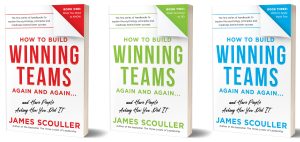By James Scouller, below, executive coach and author of How To Build Winning Teams Again And Again
 I’m often asked, “What is the key to building a winning team?” I always reply that there isn’t a single key. The reality is that building winning teams that last – and rebuilding them when they break up as they always do – is a demanding, complex challenge. Look at how many of the great professional football club managers are sacked every year. Few have shown they can build and rebuild teams over five years or more. Perhaps Sir Alex Ferguson and Pep Guardiola are exceptions, but that’s the point, they’re exceptions. Why are they exceptions? Because team building is a difficult art.
I’m often asked, “What is the key to building a winning team?” I always reply that there isn’t a single key. The reality is that building winning teams that last – and rebuilding them when they break up as they always do – is a demanding, complex challenge. Look at how many of the great professional football club managers are sacked every year. Few have shown they can build and rebuild teams over five years or more. Perhaps Sir Alex Ferguson and Pep Guardiola are exceptions, but that’s the point, they’re exceptions. Why are they exceptions? Because team building is a difficult art.
However, here I’ll suggest my three top tips: Get your blend of team roles right, nail your number one goal, and agree your decision-making approach.
Team Role Blend
The need to build a successful blend of behavioural mindsets and skills is obvious in elite sports teams. After all, what top football team would want 11 goalkeepers or 11 Diego Maradonas… one yes, but 11? However, it’s not so obvious in industry. In the business world, we assume we have the right blend if we appoint the heads of Sales, Manufacturing, Finance, Tech and HR, or perhaps regions or business units to the top team. But job titles – reflecting technical knowhow and experience in one part of the business – don’t guarantee the right behavioural blend. So, what does?
The answer is diversity of belief, thought and behaviour. This is where we turn to Meredith Belbin’s research into teams at work. He uncovered nine behaviour clusters (he called them team roles) that all business work groups need in their ranks to succeed. He labelled them Plants, Shapers, Implementers, Teamworkers, Coordinators, Resource Investigators, Monitor Evaluators, Completer Finishers and Specialists. However, don’t think all teams need nine members as many of us can play two Belbin team roles comfortably. Sometimes three.
We don’t have space here to explore each role but here’s the big point: if you’re missing key behaviour clusters (team roles) or have too many members with similar behaviour profiles, you’ll struggle to form as a team. You’ll find members clashing (or behaving passive-aggressively) and failing to agree. Or struggling to solve problems and deliver creative solutions. Or coming up with ill-considered plans. Or executing sloppily. Or launching time-wasting leadership coups.
The point is that teams need a good blend of behavioural styles and mindsets. If you focus on job titles, you’re unlikely to get the mix you want, but few teams consider their behavioural blend because most people don’t know about Belbin’s research into team roles. Now you do.
Number One Goal
All successful work groups have answered the question, “Why do we exist?” However, when you’re trying to build a successful team, knowing its reason for existing isn’t enough.
For galvanising and uniting your team members, I’ve found that defining your number one goal works better. This is the most important thing the team must achieve in the coming period, usually no more than 12 months. Why does this work better? Because its short-term outlook, precise definition of success, and emphasis on what you as a group must do brings extra urgency and ownership to would-be teams.
How do you define your number one goal? I suggest six steps:
Step #1: Draw up a shortlist of the issues, problems, challenges or opportunities facing your team. Decide which one should be your focus.
Step #2: Reframe the issue or opportunity as your team’s number one goal, expressed as a stirring theme with a maximum 12-month deadline. By “stirring theme,” I mean a rallying cry around your top challenge. This arouses energy, commitment and unity because (a) it reflects the key issue facing your group (b) it uses emotional language, not dull management jargon and (c) it’s time-limited, meaning it evokes feelings of urgency.
Step #3: Decide what metrics you’ll use to tell whether you’ve succeeded in achieving your number one goal … or are on the way to succeeding.
Step #4: Set targets and deadlines for each metric.
Step #5: Create a one-page scorecard showing the goal, metrics, targets and deadlines.
Step #6: Now make the scorecard your focus whenever you meet. That way, the number one goal and its supporting metrics and targets remain front and centre of everything you do.
Decision Making
Most teams I’ve worked with, especially senior teams, experience problems with decision-making. The typical symptoms? Repeated complaints that “our decision-making is too slow” or “we’re not getting things done.” This drags down morale and performance.
On investigating, I’ve repeatedly found that members haven’t realised the danger of not explicitly agreeing how they’ll reach team decisions. They’d assumed it was clear how they’d make decisions that stick – even though they hadn’t discussed it. Or because they’d been seduced by the idea that decisions with strong backing will somehow emerge after debate or, even if they can’t reach 100% accord, that they’ll fall in and deliver without delay. Experience shows the first idea is false and the second is fantasy.
Why is explicitly agreeing your team’s approach to decisions important? If team members don’t know how decisions are made, and therefore where power lies, or feel unhappy with their low influence over key decisions, you won’t have a winning team. You’ll face a never-ending power struggle, meaning decisions will be difficult. They’ll be agonisingly sluggish, or poorly thought through, or executed slowly or sloppily. Why? Because you never gained members’ true commitment to those decisions.
How should would-be teams address this challenge? Well, most team decisions come in non-emergency moments when there’s time for debate. So, the key is to agree how you’ll reach collective decisions at the end of your discussions. I’m aware of six collective decision-making options:
- Majority vote: If most team members vote for it, even if the leader opposes it, that’s the decision.
- Minority vote: Giving binding decision-making power to a subgroup of the team. It’s not asking them to discuss a topic and return with recommendations. Instead, the subgroup makes the call.
- Rubberstamping an expert’s decision: You pass the decision to an expert (either a member or external specialist) to decide for the team. The team merely approves the decision as a formality.
- Compromise – negotiate to a middle position: You “split the difference” by finding a halfway house answer that gives no one exactly what they want but, equally, leaves no one empty-handed.
- Consensus: Demands 100% “agreement” (but only on the face of it because often people don’t say what they’re really thinking or feeling).
- Concordance: The default version also demands 100% accord, but it’s genuine agreement because the rule is “no withholding, no little white lies, no ‘being less than candid or a little obscure’”. However, the team can concordantly agree to make decisions in other ways.
My point is that you should put “decision making about decision making” on the agenda and talk it out. Then stick to your policy.
Nailing your team blend, number one goal and decision-making policy won’t head off all your problems, especially the need for trust-building (often called psychological safety these days). Nor will it take you to high-performing team status. But in my experience, it will give you a better start than most teams.
 James Scouller is an executive coach and author of the trilogy, How To Build Winning Teams Again And Again published by Hawkhurst Publishing on 11 January 2024, each book priced at £13.99. The three-part series will be available on Amazon and all other major bookstores
James Scouller is an executive coach and author of the trilogy, How To Build Winning Teams Again And Again published by Hawkhurst Publishing on 11 January 2024, each book priced at £13.99. The three-part series will be available on Amazon and all other major bookstores


